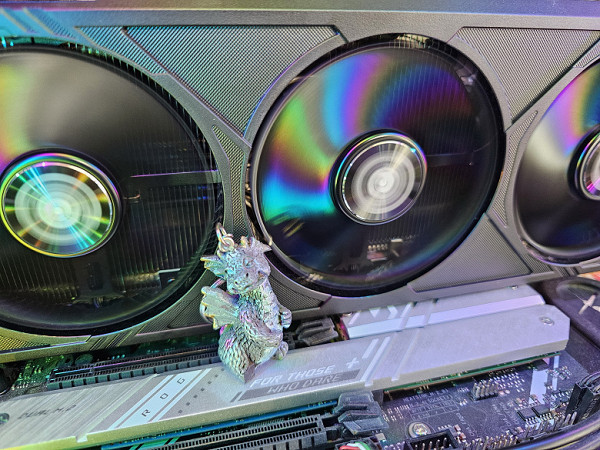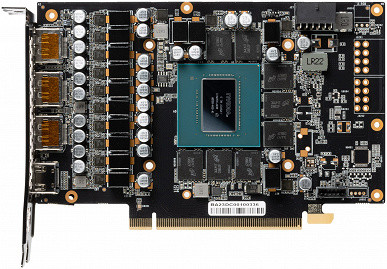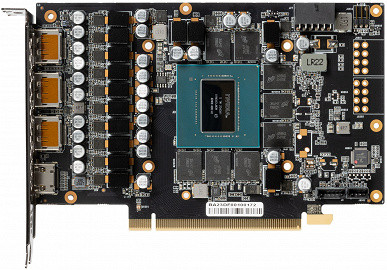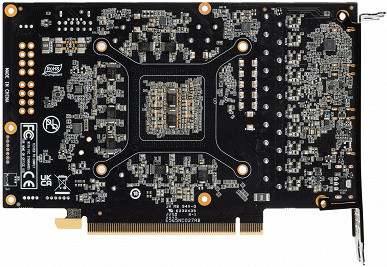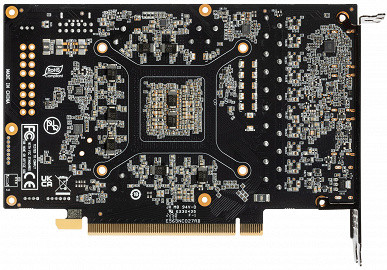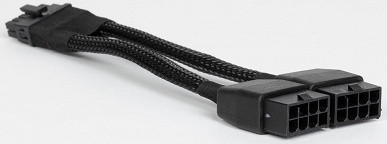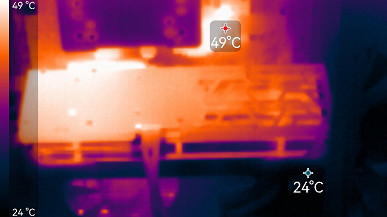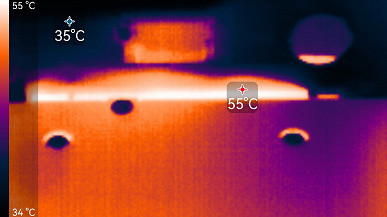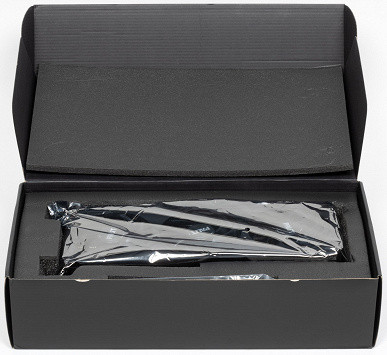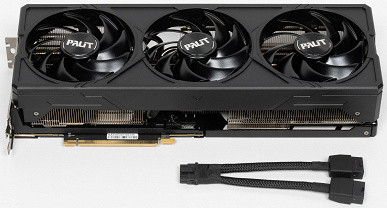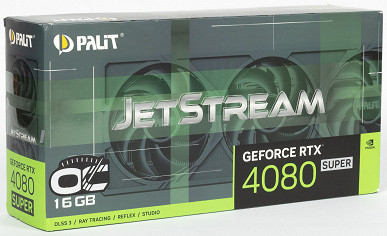Briefly about the main thing
Mass-produced video cards from the new Super generation GeForce RTX 40 subfamily continue to pass through our test laboratory.

Today we're looking at Palit's GeForce RTX 4080 Super, the second-highest performance graphics card of the current generation. The model belongs to the JetStream series, known for its simple and modest design of the cooling system. This is somewhat surprising, considering that in the GeForce RTX 30 generation, cards in this series had an interesting and futuristic backlit design. Previously, it was difficult to understand the differences between the GamingPro and JetStream series. This is probably why only a few models were released in the GeForce RTX 30 generation in the JetStream series. Now marketers have decided to make the JetStream series more modest and simple, in contrast to the GamingPro, which has stylish backlighting and the ability to modify the casing with a 3D printer.
The JetStream series now offers an efficient and massive cooling system, completely devoid of backlighting and with a sleek design. Before moving on to detailed tests, we will provide brief information about the performance of the family to which the video card under study belongs, as well as its competitors. We evaluate all this on a subjective scale of seven gradations.
Games without ray tracing (classic rasterization):
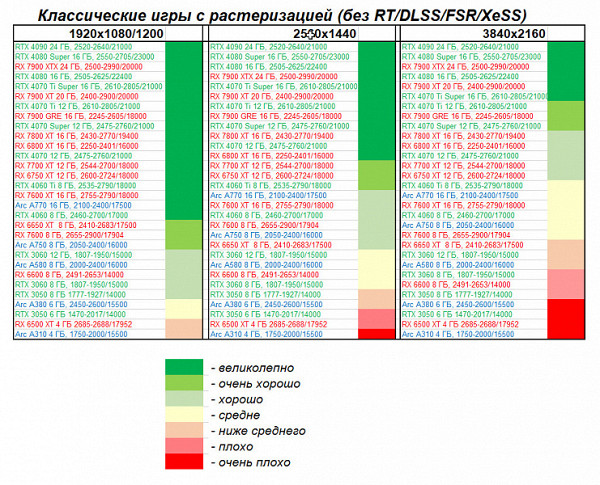
Let me remind you: in the case of top-end video cards, overall performance at 2.5K and even 4K resolutions in classic games is often limited not by the video card itself, but by other system components, such as the processor and memory. This also applies to the GeForce RTX 4080 Super. With this video card, you can enjoy full gaming comfort at resolutions up to 4K, even at maximum graphics settings (without using RT). At 8K resolution, performance will not be acceptable in all games, but in many.
Games using ray tracing and DLSS/FSR/XeSS:
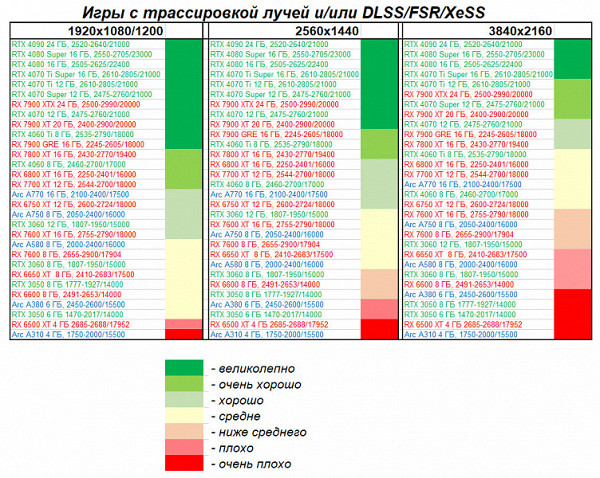
It has been known for almost 6 years that ray tracing significantly reduces performance. However, upscaling technologies from Nvidia, AMD, and Intel, found in many ray-traced games, do a great job of compensating for the drop in speed. Therefore, previous conclusions regarding resolutions up to 4K for such a powerful card as the GeForce RTX 4080 Super remain relevant. Of course, at 8K with ray tracing enabled, even using DLSS 3 will not always provide sufficient comfort, but there are still games that can be played at such a high resolution.
Card characteristics


Palit Microsystems (trademark Palit) was founded in 1988 in Taiwan. The headquarters is located in Taipei, a large logistics center is in Hong Kong, and a second office responsible for sales in Europe is in Germany. Factories are located in China. The company has been present on the Russian market since 1995, first with nameless products (Noname), and then under the Palit brand, starting in 2000. In 2005, Palit acquired the Gainward brand and assets after its bankruptcy, and formed the Palit Group holding company. Another office was opened in Shenzhen for sales in China. Currently, Palit Group includes several brands and brands.
| Palit GeForce RTX 4080 Super JetStream OC 16GB 256-bit GDDR6X | ||
|---|---|---|
| Parameter | Meaning | Nominal value (reference) |
| GPU | GeForce RTX 4080 Super (AD103) | |
| Interface | PCI Express x16 4.0 | |
| GPU Operating Frequency (ROPs), MHz | 2610(Boost)—2730(Max) | 2550(Boost)—2705(Max) |
| Memory frequency (physical (effective)), MHz | 2875 (23000) | 2875 (23000) |
| Memory bus width, bit | 256 | |
| Number of computing units in a GPU | 80 | |
| Number of operations (ALU/CUDA) in a block | 128 | |
| Total number of ALU/CUDA blocks | 10240 | |
| Number of texture units (BLF/TLF/ANIS) | 320 | |
| Number of rasterization units (ROP) | 112 | |
| Number of Ray Tracing Blocks | 80 | |
| Number of tensor blocks | 320 | |
| Dimensions, mm | 330×133×64 | 310×130×70 |
| The number of slots in the system unit occupied by the video card | 4 | 4 |
| Color of PCB | black | black |
| Peak power consumption in 3D, W | 299 | 300 |
| Power consumption in 2D mode, W | 42 | 42 |
| Power consumption in sleep mode, W | eleven | eleven |
| Noise level in 3D (maximum load), dBA | 31.0 | 32.0 |
| Noise level in 2D (video viewing), dBA | 18.0 | 18.0 |
| Noise level in 2D (idle), dBA | 18.0 | 18.0 |
| Video outputs | 1×HDMI 2.1, 3×DisplayPort 1.4a | 1×HDMI 2.1, 3×DisplayPort 1.4a |
| Support for multiprocessor operation | No | |
| Maximum number of receivers/monitors for simultaneous image output | 4 | 4 |
| Power: 8-pin connectors | 0 | 0 |
| Power: 6-pin connectors | 0 | 0 |
| Power: 16-pin connectors | 1 | 1 |
| Weight of the card with the delivery set (gross), kg | 1.98 | 3.0 |
| Net weight of the card, kg | 1.46 | 2,2 |
| Max Resolution/Frequency, DisplayPort | 3840×2160@144 Hz, 7680×4320@60 Hz | |
| Maximum Resolution/Frequency, HDMI | 3840×2160@144 Hz, 7680×4320@60 Hz |
Memory
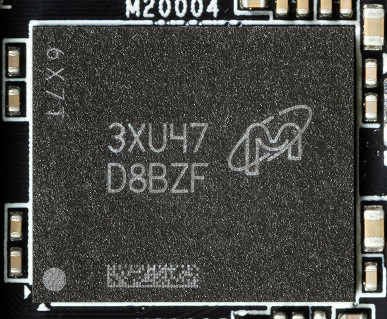
The card is equipped with 16 GB of GDDR6X SDRAM memory, distributed over 8 chips of 16 Gbit each, located on the front side of the PCB. Memory chips from Micron (model MT61K512M32KPA-24 / D8BZF) are designed for a nominal operating frequency of 3000 (24000) MHz.
Card features and comparison with Palit GeForce RTX 4080 Super GamingPro OC (16 GB)
We compare this card to a model from the same manufacturer and on the same GPU to ensure they are essentially identical. The main differences are only the absence of a backlight controller and a connector for synchronizing it with the motherboard.
The core is labeled AD103-400 and was released in week 48 of 2023.
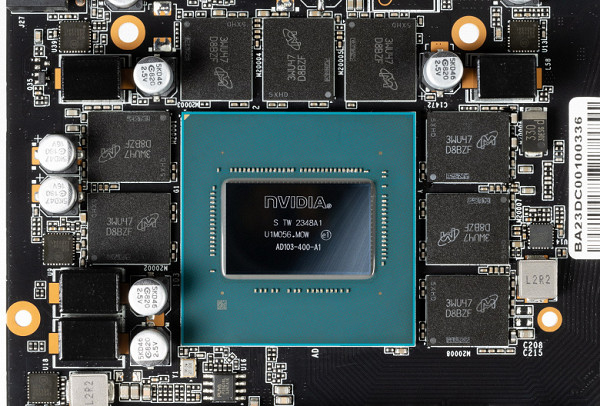
The total number of power phases for the Palit GeForce RTX 4080 Super JetStream OC card is 14 (12+2).

Green indicates the core power supply circuit, and red indicates the memory. All PWM controllers are located on the reverse side of the PCB.
The 12 phases of core power are controlled by the uP9512R PWM controller from uPI Semiconductor.

The power supply for the memory chips is controlled by the uP9529Q PWM controller (uPI Semiconductor).
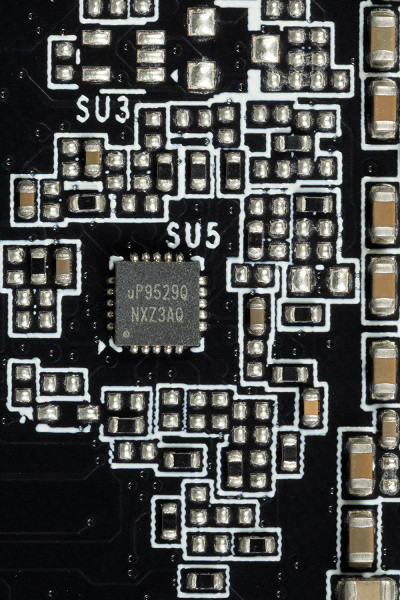
The power converter uses DrMOS transistor assemblies — in this case NCP302150 (On Semi), each of which is rated at a maximum of 50 A.
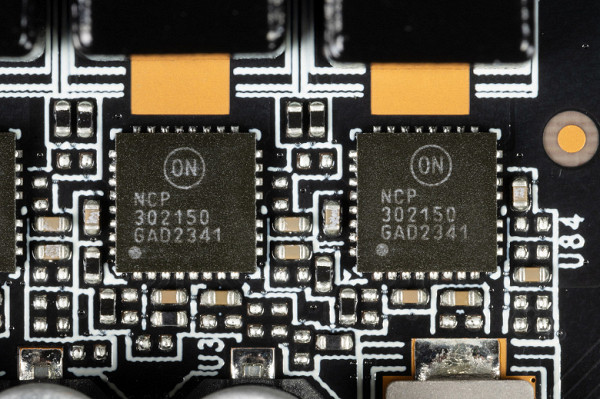
Also on the back of the board there is a uP5650Q (uPI Semi) controller, which is responsible for monitoring the card (monitoring voltages and temperatures).

The card is not backlit, so there is no corresponding controller.
The standard memory frequency corresponds to the reference one, the Boost core frequency is 2.3% higher than the reference one, and the maximum core frequency is only slightly higher than the reference one. As a result, the performance increase in games compared to the reference card averaged 2%.
The power consumption of the Palit card in tests reached 299 W (peak 327 W).
You can't increase the power limit on this card, so I didn't try manual overclocking.
Power is supplied to the Palit card via a 16-pin PCIe 5.0 connector (12VHPWR).

The card comes with an adapter for this connector from two regular 8-pin ones.
In general, the load on such an adapter is small, but we recommend purchasing full-fledged ATX 3.0 power supplies with a 12VHPWR connector and a 16-pin cable for new generation video cards.
Let us note the significant dimensions of this model, especially its thickness: 6.4 cm. As a result, the video card occupies 4 slots in the system unit.

The GeForce RTX 4080 Super does not support multi-graphics configurations such as SLI technology, and the card does not have a dedicated connector on the top end.
The operation of the card is controlled using the proprietary ThunderMaster utility, which we have written about several times before.
Heating and cooling
The basis of the CO is a massive multi-section nickel plated radiator with heat pipes that distribute heat along the radiator fins.
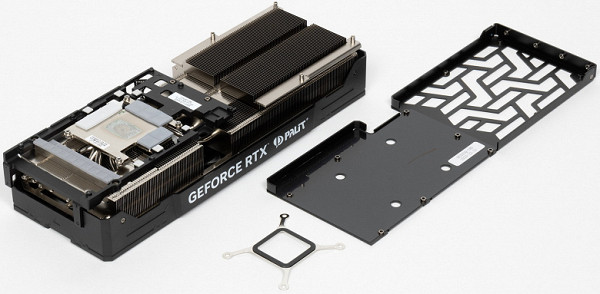
The tubes are soldered to a large nickel-plated copper plate, which cools both the core and memory chips (via thermal pads). To cool the VRM power converters, a separate heat sink is used on a massive frame, which is screwed to the radiator and also serves as a rigidity element for the entire structure.

The backplate is intended solely to protect the PCB and is part of the overall design concept.
The radiator has a casing with three fans with a diameter of 100 mm, each of which has 9 blades and operates at the same speed. By default, all fans work synchronously, but through the ThunderMaster program you can configure them to work separately for the central and two outer fans.
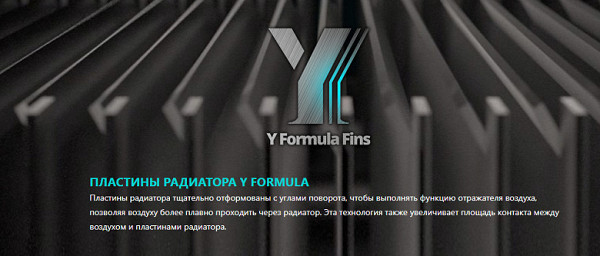
The radiator fins are made using YFormula Fins technology. Depending on their location in the radiator, the plates have different angles of inclination, which improves air flow and increases the contact area between the air and the radiator fins.
The length of the cooler significantly exceeds the length of the printed circuit board, and the right fan blows right through the radiator, being located at the rear of the card.
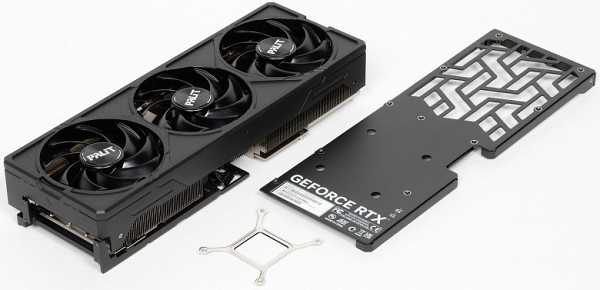
The fans stop at low load on the video card if the GPU temperature drops below 50 degrees and the memory chip temperature drops below 80 degrees. When the PC starts, the fans are turned on, but after loading the video driver, the operating temperature is polled and they turn off. Below is a video on this topic.
Temperature monitoring:
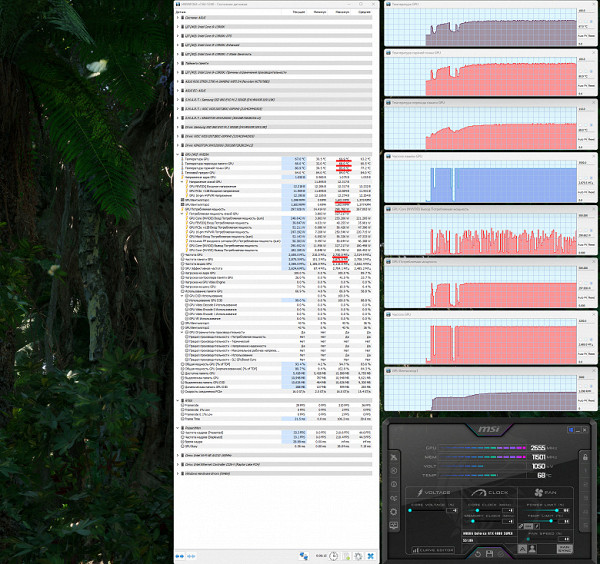
After 2 hours of work under load, the maximum core temperature did not exceed 70 degrees, with the hottest point reaching 86°C. The temperature of the memory chips was 68 degrees, which is an excellent result for video cards of this level. The power consumption of the card reached 299 W. Recall that the safe temperature limit for GDDR6X memory is 105°C.
We recorded and sped up the 8-minute warm-up process by 50 times:
The maximum heating was observed in the central part of the PCB and at the PCIe and power connectors.
Do not forget that the heat generated by the card remains inside the system unit, so using a case with good ventilation is highly desirable.
Noise
The noise measurement technique assumes that the room is soundproofed and attenuated to minimize reverberations. The system unit in which the noise of video cards is studied does not have fans and is not a source of mechanical noise. The background noise level is 18 dBA — this is the noise level in the room and the sound level meter itself. Measurements are taken from a distance of 50 cm from the video card at the level of the cooling system.
Measurement modes:
- Idle mode in 2D: an Internet browser with the site iXBT.com, a Microsoft Word window and a number of Internet communicators are loaded.
- 2D mode with movie viewing: SmoothVideo Project (SVP) is used — hardware decoding with insertion of intermediate frames.
- 3D mode with maximum load on the accelerator: FurMark test is used.
Noise level rating:
- less than 20 dBA: relatively silent
- 20 to 25 dBA: very quiet
- from 25 to 30 dBA: quiet
- from 30 to 35 dBA: clearly audible
- from 35 to 40 dBA: loud, but tolerable
- above 40 dBA: very loud
In idle mode in 2D, the temperature was no higher than 37°C, the fans did not work, and the noise level was consistent with the background — 18 dBA.
Nothing changed when watching movies with hardware decoding.
At maximum load in 3D, temperatures reached 70/86/68°C (core/hot spot/memory). At the same time, the fans spun up to 1600 rpm, and the noise increased to 31.0 dBA: this is already clearly audible, but not yet loud.
Noise spectrogram (no obvious problems):
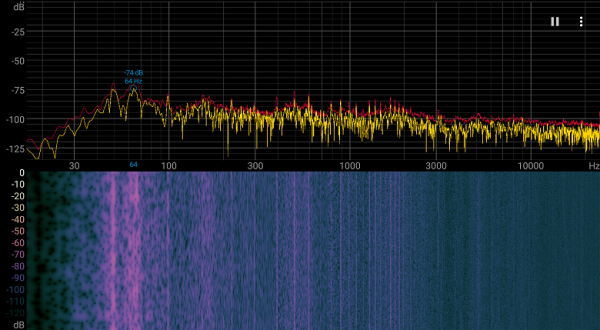
Backlight
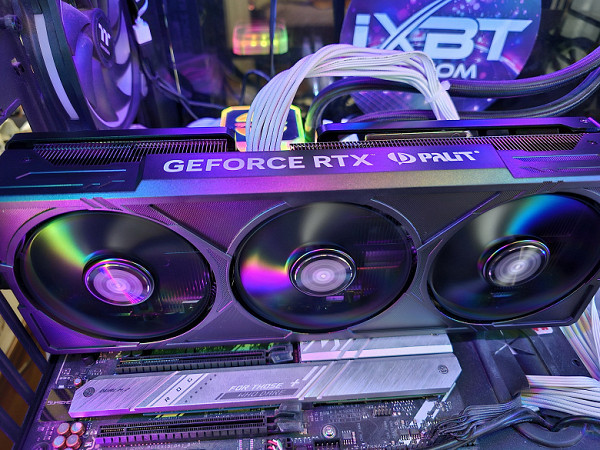
The map is not backlit.
Delivery and packaging
In addition to the card itself, the package includes only a power adapter.
conclusions
Palit GeForce RTX 4080 Super JetStream OC (16 GB) is a flagship video card, the second most powerful in the GeForce RTX 40 family of gaming accelerators from Nvidia. The GeForce RTX 4080 Super is designed to replace the GeForce RTX 4080 and is positioned one level higher than the GeForce RTX 4070 Ti Super. A distinctive feature of this video card is its strict black design and lack of backlighting, which can be useful for those who prefer to save money and who do not care about the appearance of PC components. Additionally, Palit's JetStream series is more affordable than the GamingPro or GameRock series.

The Palit card can consume up to 300W. The cooling system is powerful and efficient, but not quiet. The dimensions of this model are 33 cm in length, 13 cm in height, and in thickness it occupies 4 slots in the case. The set of video outputs is standard: 3 DP 1.4a and 1 HDMI 2.1.
Palit GeForce RTX 4080 Super JetStream OC has a 16-pin PCIe 5.0 power connector. The package includes an adapter adapter for connecting via PCIe 2.0 power connectors (from two such connectors), but it is preferable to use ATX 3.0 standard power supplies with full support for PCIe 5.0 (with a 12VHPWR cable).
The manufacturer provides a 3-year warranty on this card.
The GeForce RTX 4080 Super is great for gaming at resolutions up to and including 4K with maximum graphics quality, both classic non-RT games and ray-traced games, even without DLSS support.
Also worth noting is support for the HDMI 2.1 standard, which allows you to output 4K images at 120 FPS or 8K resolution via one cable, support for hardware video decoding in AV1 format, and RTX IO technology, which ensures fast transfer and decompression of data from drives directly to the GPU. However, as far as the DisplayPort standard is concerned, version 1.4a is still used here.
